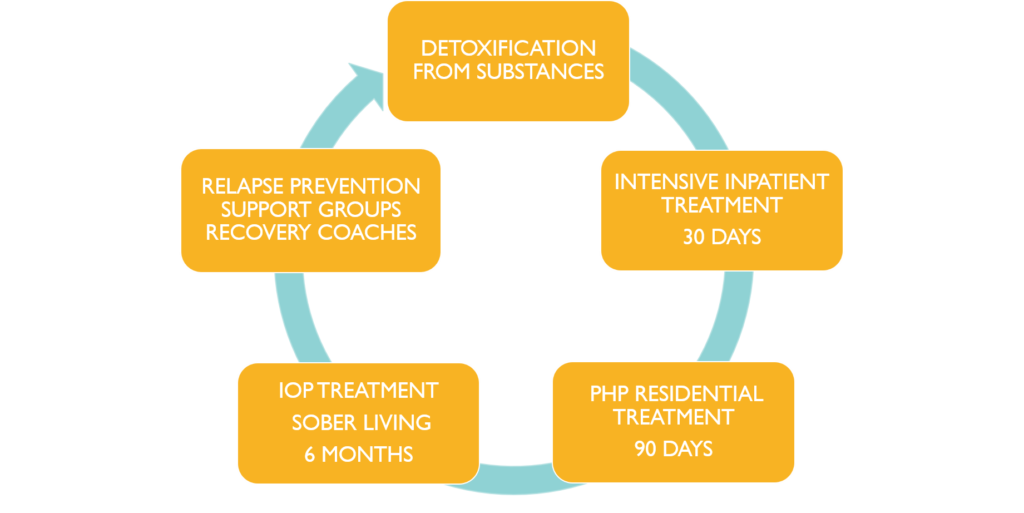By Mary Cucarola – 11/3/20
“Healing is an art. It takes time. It takes practice. It takes love.”
From my personal experience over the past six years working with individuals trying to recover from addiction, I have found these five steps form the foundation for a successful recovery. I have seen it work time after time, and wish I had known this information when Cody was on his addiction journey. Maybe it will help you or someone you love.
- Medical detoxification from substances. Manages the acute and potentially dangerous effects of stopping drugs & alcohol abruptly. Medications are available to assist in an easier, safer, tapered withdrawal and makes it more comfortable for the patient.
- Intensive inpatient treatment. Used for very ill patients who need 30 days of intensive inpatient care. Medical doctors and nurses on site, structured program to address all facets of addiction, including dual diagnosis. Medication assisted treatment (MAT) may be recommended at this stage, depending on the substance used.
- Long-term residential treatment with PHP. Stepping down from intensive inpatient treatment to 90 days of residential treatment in a partial hospitalization program (PHP). It has been demonstrated that 30 days of treatment is not sufficient to provide a solid foundation for recovery. Some individuals may not need intensive inpatient treatment because they have been in rehab several times before or are not in need of intensive care, but they definitely need at least 90 days of residential treatment. Shirking on this step lessens the probability of success.
- Sober living environment with IOP. Upon release from residential treatment, the recovering individual should be transported directly into a sober living environment, continuing treatment in intensive outpatient treatment (IOP) with an addiction counselor, individual and group therapy, and support groups. MAT may be continued to reduce cravings and prevent relapse. Frequent drug testing is performed to detect any signs the addict is using his or her drug of choice. A return to work or school usually occurs in this environment and is an important aspect of becoming fully functional and builds self-esteem and can offset the shame that accompanies addiction. Living in a sober living environment for six months is the best outcome.
- Relapse prevention plan. The recovering individual needs a firm footing in a recovery community like AA, NA, CA, Smart Recovery, Celebrate Recovery, or some recovery support group where he or she can learn sober ways of thinking and observe people who are creating sober lives for themselves. AA and other support groups offer a community in which to develop personal connections and to feel a sense of belonging. They also need to utilize a sponsor and/or recovery coach to be held accountable for their sobriety. Also, fun is an important part of relapse prevention. The dopamine that has been depleted in addiction needs replenishment. Learning sober ways to produce pleasure is essential to rebuilding the natural supplies of dopamine. Without dopamine, recovery won’t be appealing and the option of returning to drugs and alcohol in order to feel good will be compelling. My son always returned to the golf course when he was sober because he found so much enjoyment in golfing. Some recovered individuals exercise, play sports, mountain climb, ride bikes, run,work hard, or whatever helps to elevate their dopamine levels naturally.
Following these five steps takes time and can be difficult, which is why individuals in recovery and their family members need support, education, and guidance in building a solid recovery platform.
Dr. Kevin McCauley, an addiction physician and in recovery himself, works with addicted pilots, who are highly motivated to recover and return to work, and he recommends these same principles in his “Ten Principles of Successful Addiction Treatment”, which he claims has a 95% success rate of recovery. Each compromise in adherence to his program principles can reduce the chance of a successful recovery according to Dr. McCauley.
Each of these five steps I have covered is included in his principles of successful recovery and can work if adhered to by addicted loved ones and supported by their family members. It takes time, but it’s worth it. What I have learned in doing this work is there are many paths to recovery, but mostly it is a healing process that takes a long time and can’t be done in isolation.
Mary Cucarola – 11/3/20


